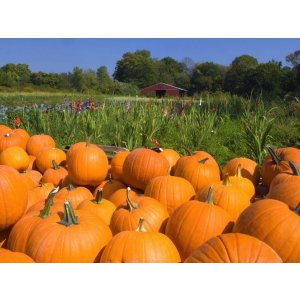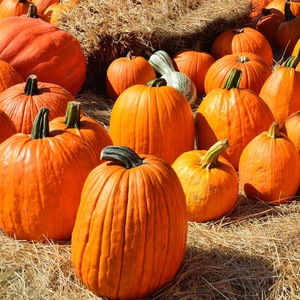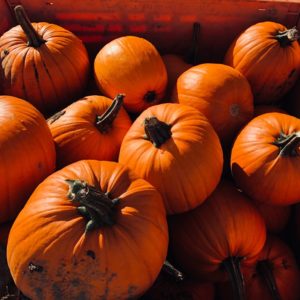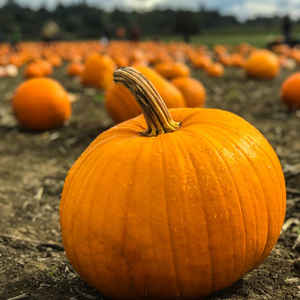How to harvest on time: when to harvest pumpkin from the garden in the middle lane
The summer season is in full swing. Some crops are just ripening, while others are already yielding. Pumpkin is considered the queen of autumn. For the sake of nutritious seeds, it began to be grown 8000 years ago in Mexico, and in the 16th century it was brought to Europe. Fruits are valued for their high content of vitamins, trace elements, fatty acids. Porridge, pies, juices are prepared from the pulp. Our post is about when to harvest pumpkins.
The content of the article
When to remove pumpkin from the garden in the middle lane
Gathering pumpkin in different climatic zones differs somewhat in terms of timing. It is important to define them correctly, taking into account all the nuances.
Timing
Gathering pumpkin is associated with autumn, because by this time the culture is fully ripe, the fruits become tasty, having accumulated useful substances.
In central Russia the collection is carried out not too early, since the duration of storage of the fruits directly depends on their ripeness. The optimal timing is from mid-September, and in more southern areas - after the leaves are completely dry.
What the timing depends on
From pumpkin variety its growing season depends. The manufacturer indicates this information and the nuances of caring for the vegetable on the package with seeds.
The ripeness of the pumpkin is determined by the weather characteristics of a particular climatic zone and the type of culture. There are 3 groups of varieties: early ripening, mid-ripening and late-ripening. This is what mainly affects the harvest time.
Early ripening varieties reach maturity by the end of July - early August. Pumpkins have a pleasant taste and light aroma. The fruit does not have a dense enough peel, so they are not stored for long. The growing season is 92-104 days.
Mid-season varieties are large, thick and hard pumpkin skins. Their shelf life is an order of magnitude longer if you harvest before the first frost. The growing season is 110–120 days.
Late-ripening varieties are distinguished by the largest sizes and the longest storage period (up to six months). Their growing season is within 200 days. The advantage of such pumpkins is the ability to ripen outside the garden. During storage, the fruits acquire a richer taste, juiciness, sweetness and aroma. The typical light orange color serves as a kind of indicator of the harvest of late-ripening pumpkins.
Varieties with large fruits ripen in the beds until mid-October, which allows vegetables to acquire a rich taste and juiciness. Moreover, if you overexpose the pumpkins, their quality will suffer from both a long delay on the stems and from the first frosts.
Exact calculation
Depending on the variety of culture in central Russia, they adhere to the following terms:
- early ripening pumpkins are harvested from the garden in August - early September;
- mid-season - in September - early October;
- late ripening - in September - October (before frost);
Auspicious days according to the lunar calendar
Harvest on a sunny and warm day. It is optimal if it falls on good days according to the lunar calendar. So, it is best to collect pumpkins, toWhen the waning moon is in Gemini, the waxing moon is in Scorpio, in any phase it is in Sagittarius, Capricorn and Aquarius.
In 2019 favorable dates:
- 6, 7, 16-25 August;
- 2–4, 1Z – 22, 30 September;
- October 1, 11-19, 27, 28.
How to determine the ripeness of the fruit
Ripe fruits have excellent taste and juicy flesh. The maturity of the pumpkin is determined by external signs or using some techniques.
External signs
Certain changes in the fruits make it clear that they are ripe and ready to be harvested:
- A dry, hard, cork-like stalk is typical for ripe fruits, and green and juicy for unripe ones.
- Dried and yellowed leaves (most of them) indicate maturity.
- Different types of pumpkin, as they ripen, acquire a color from dark orange and yellow to gray-green. Long-term stored large-fruited varieties are characterized by brighter and more saturated shades. In the most fragrant and sweet muscat and small-fruited varieties and well-stored hardy varieties, the color changes significantly during ripening, acquiring a special pattern.
Life hacks for verification
A few simple tricks allow you to determine the ripeness of a vegetable.
The first option is to put a little fingernail pressure on the fetus. If you cannot leave a dent or it is obtained with great difficulty, then the pumpkin is ripe.
Another way is to tap the surface of the vegetable. Ripe fruit gives a dull sound.
Harvesting rules
Ripe fruits are harvested in clear dry weather. Pumpkins harvested on a rainy day are much worse stored. If, nevertheless, it turned out to be a damp day, wet fruits are dried for 10-15 days in a dry warm place on a straw substrate. In sunny weather, pumpkins are dried directly in the garden, then put away for storage.
Ripe vegetables are cut with a sharp knife or pruner, leaving a 5–10 cm long stem. This prevents bacteria from entering and rotting.
Attention! The fruits are transferred very carefully, preferably not by the stalk, since even minor damage and scratches reduce the shelf life, especially in large-fruited varieties.
Damaged vegetables are consumed in the near future, since they do not lie for a long time. Small cuts and scratches on the peel are treated with brilliant green or sealed with a bactericidal plaster.
Further storage
Late-ripening varieties harvested before the first frost are ripened for 1-2 months in a dry warm place at a temperature of + 25 ... + 27 ° C and a humidity of 85%. After that, the fruits are not stored for a long time, so they are consumed as quickly as possible.
Important! It is better to keep vegetables in a dark, well-ventilated place at + 10 ... + 15 ° C and 70–75% humidity. For this basement and cellar suitable.
In a city apartment, there are also suitable conditions (for example, under the closet). The temperature is maintained no higher than + 20 ° C.
The pumpkins are laid out on a bed of sawdust, straw or waterproof fabric so that they do not touch each other. Do not keep them together with other vegetables and fruits, especially apples and pears, which release ethylene, which speeds up ripening and reduces shelf life. In cold weather, the fruits are covered with a layer of hay or straw.
The highest keeping quality is in large-fruited pumpkins, fully ripe. They form large amounts of starch, which hydrolyze as they are stored to soluble sugars, which gives the fruit a sweetness. Such vegetables retain their nutritional and healing properties for up to six months, after the pulp begins to dry out, becomes fibrous and loses its taste.
Muscat pumpkins are slightly worse - up to 4 months.
The indicators are even lower for early-ripening, hard-barked vegetables - no more than 1 month. Their flesh is thin, fibrous, so it dries quickly, and the seeds begin to germinate. The fruits themselves are unsweetened, but the seeds (with or without thin skin) have an amazing taste and are very useful.
If it is impossible to keep fresh from the pumpkin, make preparations: jam, candied fruit, dried and frozen slices.
Useful Tips

Experienced vegetable growers give recommendations for picking pumpkin:
- The fruits are harvested before the first frost, on a clear and warm day, twisting the stalk along its axis. So the fruits will better retain their juiciness.
- When cold nights come, vegetables that have not yet been removed are covered with something warm.
- The largest and ripe specimens are selected for seeds.
Conclusion
Calculating the timing of the pumpkin harvest is easy.It is enough to know the characteristics of the variety, take into account the climatic conditions of the area, choose a dry and clear day. Then the harvest will be stored for a long time, and you can enjoy dishes from a healthy vegetable.